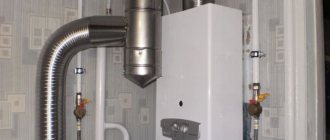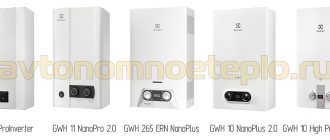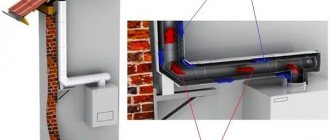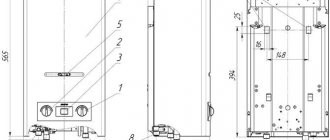Flaws
Among the most common comments is the message that the batteries that provide automatic ignition have to be changed very often, and it is advisable to use only high-quality and expensive ones, but it is also noted here, as an advantage, that the operation of the gas water heater is independent of the presence of voltage in the electrical network .
Some users complain that the protection system is too strictly configured, which allows normal operation of the column only in the case of low water flow and when the water pressure in the system is stable. Large changes in the outlet water temperature occur in the event of pressure drops, and there is no automatic adjustment of the temperature regime. It is quite difficult to manually set the required indicators; in any case, there are doubts about what the real outlet water temperature will be.
Regarding breakdowns and repairs of Vektor speakers. Judging by the reviews, unit breakdowns occur quite often. Among the most vulnerable parts is the heat exchanger tube. When removing the heat exchange unit for self-cleaning, many users experienced various kinds of difficulties. Not every locality has spare parts in stores, except perhaps the heat exchanger, and the price for them is not very affordable. There are cases when Gorgaz refused to repair devices, citing the refusal by the fact that their employees are not sufficiently familiar with the design of water heaters of this type.
Among the significant disadvantages of the device, it is noted that during long-term operation of the column (3-5 years), the process of its activation is disrupted - due to untimely ignition of the gas, it can be accompanied by an explosion. Naturally, the owners begin to feel fear when starting the unit.
Having studied numerous reviews about the operation of the Vector geyser, we can draw some conclusions - the operation of the device is not as simple as it seems at first glance, it requires an understanding of the main aspects of the operation of the unit and the possession of some skills in its rational operation. The occurrence of some operational problems is most likely caused by the illiterate operation of the water heating device.
Electronics malfunction
The draft sensor in geysers is usually located on top. It is attached to the chimney.
Modern geysers have many electronic units and sensors on board - only the simplest models do not have them. Sensors monitor draft and the presence of flame (ionization control), monitor the water temperature and automatically regulate the degree of its heating. If one of the sensors fails, the gas water heater will malfunction. The most typical malfunction is a breakdown of the draft sensor in the exhaust gas manifold. As a result, the electronics will not give the go-ahead for ignition.
Failures also occur in electronic modules installed in many geysers. Repairing them is complicated by the fact that this requires special knowledge in the field of electronics and circuit design. If you are sure that electronic components are faulty, but do not have the necessary knowledge, feel free to call a specialist.
Precautions for using the speaker
Before starting any equipment, you should carefully read the operating instructions. This also applies to the gas water heater. Basically they work on the same principle, but the following safety measures should be applied to all of them:
- Carry out regular maintenance and cleaning. This will lead to safe operation.
- To do cleaning correctly, you need to find a specific section in the instructions for the unit dedicated to this topic.
- Monitor the heating of the heat exchanger.
- Check smoke outlets periodically. Make sure they don't get clogged.
- If you notice any irregularities in operation, immediately call the gas service.
Under no circumstances should you repair the damage yourself.
How to ignite the device
After the device has been installed, the gas water heater is started for the first time. First of all, open the water and gas supply taps. Then, the column is turned on, presented in three ways.
Manually
This method was used in older type columns. You can start the gas water heater only with matches. Fireplace matches are considered the best option for ignition.
In this case, the following actions are performed:
- Open the tap on the water pipe related to the column;
- Turn the gas supply valve;
- The wick is lit with matches;
- The fuel supply valve is turned and the water temperature is adjusted using a special lever.
Reference! The device cannot be turned off until the tap is closed manually.
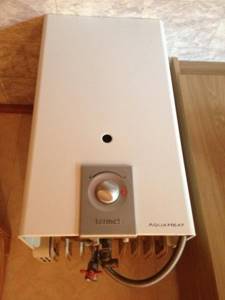
It is not difficult to light an old gas water heater. Switching off is done exactly the opposite. First of all, you need to turn off the wick, turn off the gas, and then turn off the water.
It is worth working with the old type samples very carefully. Otherwise, an explosion, device failure, or gas leak will occur.
Using piezo ignition
A semi-automatic device with no batteries, having mechanical switches in the form of handles. To ignite it, you need to get a spark.
The following manipulations are performed:
- Open the fuel transfer;
- Clamp the solenoid valve for twenty seconds to obtain a decent amount of gas for the flame;
- Press the piezo ignition key;
- As soon as the wick lights up, set the required indicators on the temperature regulator.
Why does the speaker turn on by itself?
Each water heater, regardless of the year of manufacture, has an automatic device designed to prevent the device from igniting on its own. For this reason, situations where the geyser turns on itself without water are excluded. The “frog” water regulator is responsible for this.
If a gas water heater turns on spontaneously without water, the problem may be that there is a leak somewhere in the hot water pipeline, possibly running in the wall. Once the leak is fixed, the problem will disappear.
Much more often, users are faced not with the fact that the column turns on by itself without water, but with the fact that after turning off the tap it continues to work. The reason lies in the diaphragm located inside the water regulator, hardened by hard water. After turning off the hot water, the membrane is in no hurry to return to its place, continuing to press the rod that opens the gas supply. The problem can be corrected by replacing the diaphragm.
There is no required pressure in the water supply
This problem often occurs on the upper floors of buildings. If the water supply does not have the minimum pressure for which the column is designed, it will not start. The water-gas block has a Venturi tube. It is designed in such a way that if the pressure decreases below the design value, the rod will not be able to open the gas valve. First, open the cold water tap in the shower. If the pressure is weak, this is not yet a reason to grab the tools and start repairing the column. Ask neighbors regarding water pressure. If the problem is in your apartment, start with the fine filter, it may be clogged with dirt. The filter is located at the inlet of the column and is unscrewed with an adjustable wrench.
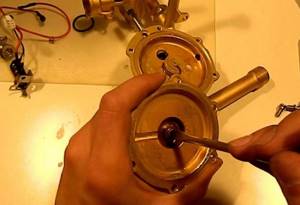
Checking the condition of the rod seal
If, nevertheless, the water pressure is normal, and the water heater still does not work, you will have to disassemble the water-gas group and check the condition of the membrane. The water-gas group is the main equipment that affects the ignition of Bosch instantaneous water heaters.
To check, follow these steps:
- Turn on the hot water in the kitchen.
- Shut off the gas at the inlet to the column.
- Remove the front panel; it is secured with two screws from the bottom.
- Disconnect the gas fittings from the gas group.
- Disconnect the fittings at the inlet and outlet of the water group.
- Remove the water-gas group.
- Unscrew the screws securing the two halves of the frog.
- Separate the two plates and inspect the membrane.
- Check the condition of the seal in the rod seal.
- Check the rod and clean it of dirt.
- Replace the membrane or seal if necessary and reassemble the water-gas unit in the reverse order.
- Connect it to an instantaneous water heater and assemble the column.
Pay attention to the condition of the gas valve stem. If the seal is clogged with calcium salts or dirt, it may become deformed.
When assembling, lubricate the rod with any machine oil so that the pair of rod and oil seals are lubricated.
Turning on the device
The first step is to install the batteries. To do this, open the battery compartment and install them, observing the polarity. Then you need to open the cold water and gas valves. Open the hot liquid tap on the nearest faucet.
At the moment when the liquid flows through the water unit, a spark ignition occurs and, thanks to this, the burner ignites. If it is turned on for the first time or after a long period of inactivity, air may accumulate in the gas line; in order to remove it, you will need to open the mixer several times, hold it for a minute, and then close it.
If the burner ignites, you need to turn the water pressure adjustment lever (located on the right) to the right, this will make it possible to turn on the Vektor JSD 20 device when the liquid pressure in the system has decreased.
Is it possible to turn on cold water when the water heater is running?
Doing this is strictly not recommended for several reasons:
- Manufacturers prohibit turning on cold and hot water at the same time, as stated directly in the operating instructions. You need to initially set a comfortable temperature that allows you to do without mixing. Opening the cold water tap affects heating and causes rapid failure of the water heater.
- The main reason why you cannot turn on cold water when the gas water heater is operating is that this malfunction leads to a rapid build-up of scale in the heat exchanger.
For ease of use, modern automatic gas flow-through columns have a “winter-summer” mode. The function helps to quickly change the heating temperature and reduce gas consumption.
Removing burner blockage
Unfortunately, the burners in the Neva and Oasis gas water heaters (as in many others) are susceptible to blockages. Most often, this picture is observed in models with piezoelectric ignition. The cause of clogging is the accumulation of soot. It needs to be removed, for which the column is disassembled and the burner itself is removed from it. Any available tools are used for cleaning. After cleaning, the burner should be reinstalled and checked. If necessary, you can immediately clean the heat exchanger - its clogging leads to loss of traction and deterioration of heating.
Why does the system light up on its own?
Even the oldest gas water heaters are equipped with devices designed to prevent spontaneous operation. This function is usually performed by the water flow regulator. If the dispenser still ignites when the tap is closed, leaks may occur in hot pipelines. Having eliminated such a leak, you can use the water heater again without any worries. When the tap is turned on and the combustion does not stop, you need to change the diaphragm; it is too overgrown with hardness salts and reacts slowly or does not react at all.

The right choice of geysers
If you decide to purchase a geyser device, then pay attention, first of all, to the power of the model you choose. It should be enough to provide all members of your family with hot water.
The power of almost all modern models fits into the range from 3 to 60 kilowatts.
Important! The more powerful the gas water heater, the larger volume of water it will be able to heat over a certain period of time. The average “cell of society”, consisting of four people, needs a device whose power averages 16-24 kilowatts
There is more than enough for the dishes to be washed and everyone to take a shower. Even if the device has a low power of 16 kilowatts, it will be able to provide 10 liters of hot water, which is enough to wash and wash dishes at the same time. Of course, if you can, then buy a column with a power of 24 kilowatts, as it can provide 24 liters of heated water
The average “cell of society”, consisting of four people, needs a device whose power averages 16-24 kilowatts. There is more than enough for the dishes to be washed and everyone to take a shower. Even if the device has a low power of 16 kilowatts, it will be able to provide 10 liters of hot water, which is enough to wash and wash dishes at the same time. Of course, if you can, then buy a column with a power of 24 kilowatts, as it can provide 24 liters of heated water.
In addition, it is advisable to take into account the water temperature that a particular model can provide. To designate it, the Latin letters DT are used. For example, if water already enters the heat exchanger at a temperature of 12 degrees, then it will heat up to 24 degrees. therefore, it can be used even without prior dilution.
Today there are models that can heat water even up to 50 degrees. Their power, as well as their cost, is an order of magnitude higher than conventional models. For this reason, if several plumbing elements are simultaneously connected to the system, then it is better to purchase a more powerful column so that it can provide them all with hot water at the same time.
Also, when buying a gas water heater, check whether it is equipped with safety sensors. They are of the following types:
- overheating;
- burner extinction;
- combustion;
- low blood pressure;
- temperature;
- sudden interruption of water supply.
And remember: geysers are only allowed to be installed in the kitchen! Installing a geyser in the bathroom is prohibited! Unless it (the bathroom) meets all existing requirements.
As a conclusion
So, we have looked at what a geyser is, what its features are, what malfunctions may arise during operation and how to repair them later. We only note that such devices are extremely economical, especially in light of ever-increasing utility tariffs. And lastly: do not forget that preventative maintenance of the column’s performance should be carried out annually.
Modern gas devices presented on the market of household water heating equipment meet all European quality and safety standards, and at the same time have a relatively low cost.
But before lighting the Ariston gas water heater and starting to use it, the owner must carefully and in detail familiarize himself with its principle of operation, operating instructions and safety regulations. This is exactly what we will talk about in detail in our article, providing the material with visual photos and video recommendations.
Troubleshooting new equipment
New equipment may also experience various problems. Most often they manifest themselves in the operation of the flow sensor, in the operation of the candle, or in the power system. Let's take a closer look at these problems.
Column microswitch failure
Often the problem with a loud bang during ignition is the insufficient discharge of batteries, which provokes the inability to instantly ignite the gas-air mixture.
The power supply is connected to the control unit via special microswitches, which are responsible for generating a signal to activate the ignition when the DHW tap is opened. If the signal arrives at the wrong time, this causes the problem. This malfunction occurs most often due to oxidized contacts. The microswitch cannot be repaired; it will need to be replaced.

If the microswitch breaks down, repairs cannot be carried out, since this system will have to be completely replaced
Flow sensor malfunction
Often the problem with popping is the flow sensor. It is located in the input circuit. A signal is sent to the control unit controller indicating the presence of liquid in the pipe. The data instantly activates the ignition system. Intensive use of this element creates an increased risk of breakdowns. For example, contact groups can be oxidized.
Such sensors are most often manufactured in a non-separable design, therefore, if a problem occurs, they cannot be repaired and must be replaced.
Working candle offset
The problem may be with the spark plug. After applying voltage, it provokes the formation of an electric spark. Modern candles are made in such a way that they can last for a long time. Element failures are rare, but they do happen.
The most common occurrence is that the ignition device is displaced relative to its nominal position. It can occur as a result of repeated heating and cooling. Such processes are associated with changes in the dimensions of individual structural elements. As a result of adjusting the position of the spark plug, the spark parameters become normal, and extraneous noise completely disappears.
Incorrect operation of the ignition retarder
A rare breakdown is considered to be incorrect operation of the ignition retarder. When disassembling the column, you need to remove the water regulator. On its cover there is a hole in the bypass channel, in this hole the ball is located. The adjusting screw determines the position of the ball.
If, when shaking the lid, you hear the sound of a moving ball, then you should not manipulate this part further. If there is no knocking, then you can move the ball using a thin copper or aluminum wire through the passage channel hole, which is located in the regulator cover.
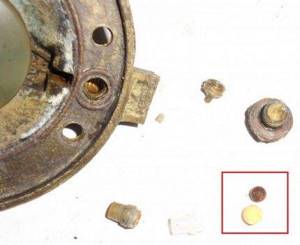
Most often, the retarder is a ball of metal or plastic that blocks part of the bypass channel in the water regulator. In most column designs, this moderator is located in the boss of the water regulator cover.
As a last resort, you will have to resort to the procedure of parsing the element. It must be said right away that the external screw does not affect the position of the ball in any way.
The inner screw must be removed very carefully. You should first remember its initial position, and also clearly determine the number of revolutions by which this screw is screwed in
This will allow you to maintain the required location of the element (ball) during subsequent assembly.
After repair work, be sure to check all connections to completely eliminate leaks of both water and gas. All connections must be treated with a sealant to ensure tightness. After which you can put the casing in place and use the column as usual.
Electrolux geyser installation
They have a standard design basis, similar to analogues from other manufacturers. A distinctive feature is a multi-level equipment protection system, which is equipped with more functional models:
- Level 1 – draft sensor, which turns off the device if this parameter is insufficient or if reverse draft occurs;
- Level 2 – thermostat that protects the gas water heater reducer and other elements from overheating;
- Level 3 – hydraulic valve that regulates the water level inside the heat exchanger;
- Level 4 – control of flame ionization.
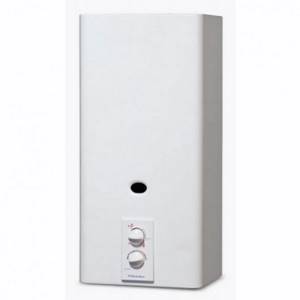
Checking traction
If your column is equipped with an open type chamber, then before you start ignition, you will need to check the presence of draft. This is important because in its absence the equipment cannot be operated. Modern models have built-in special sensors that prevent the dispenser from starting in the absence of traction or turn off the device if it disappears. However, you should not always blindly rely on automation: even if you have a new generation column, knowing how to check the traction yourself will not be superfluous. There are special measuring devices. As a rule, the average user does not have these, but there are two popular methods.
Method No. 1
- Take a regular sheet of paper and cut it into pieces.
- Remove the front part from the device.
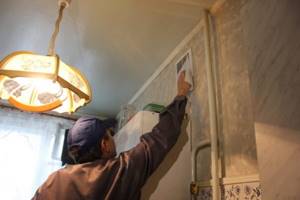
Bring a piece of paper to the chimney
- The piece of paper is pulled in - there is a pull, the piece of paper remains motionless - there is no pull.
Method No. 2
- Take a match, light it.
- Bring it to the inspection hole (located on the front panel of the speaker).
- The light should “pull” inward. If this does not happen, there is no traction.
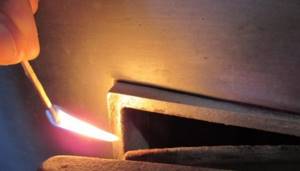
With good draft, the fire will be directed inside the hole
Attention: if the smoke exhaust pipe is working and there is no draft, open the window, thereby ensuring the flow of fresh air.
